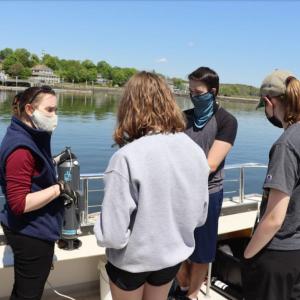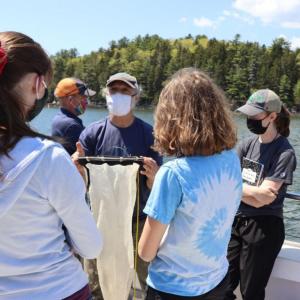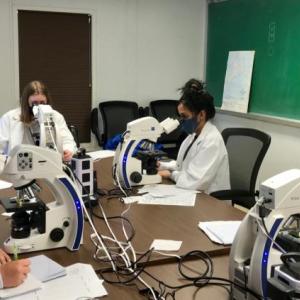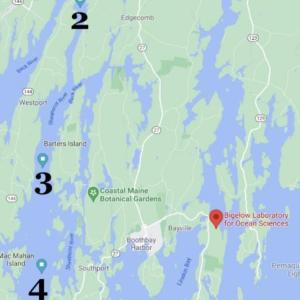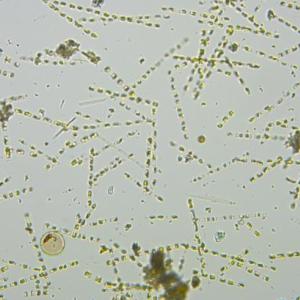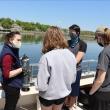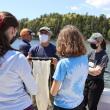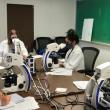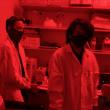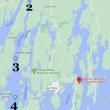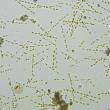Enjoyed Keller BLOOM program at Bigelow
 Water collection with Dr. Poulton, holding a YSI. Courtesy of Bruce Wood
Water collection with Dr. Poulton, holding a YSI. Courtesy of Bruce Wood
 Collecting zooplankton and phytoplankton with Dr. Fields. Courtesy of Bruce Wood
Collecting zooplankton and phytoplankton with Dr. Fields. Courtesy of Bruce Wood
 Eye-counting and identifying the various phytoplankton with Laura Lubelczyk, a research assistant in phytoplankton. Courtesy of Laura Lubelczyk
Eye-counting and identifying the various phytoplankton with Laura Lubelczyk, a research assistant in phytoplankton. Courtesy of Laura Lubelczyk
 Physical and chemical testing with Sydney Greenlee using the Seal AA3 Auto Analyzer. Courtesy of Sydney Greenlee
Physical and chemical testing with Sydney Greenlee using the Seal AA3 Auto Analyzer. Courtesy of Sydney Greenlee
 The locations of the four stations are shown in bold black numbers. Station 1 is upriver in Wiscasset, heading down river is Station 2 in the Narrows, Station 3 in the Gut, and Station 4 is off Southport island. Google Maps
The locations of the four stations are shown in bold black numbers. Station 1 is upriver in Wiscasset, heading down river is Station 2 in the Narrows, Station 3 in the Gut, and Station 4 is off Southport island. Google Maps
 This photo, taken by a telescope, shows a low biodiversity due to the dominant amount of skeletonema, who look like thin lines made up of rectangles. Courtesy of Laura Lubelczyk
This photo, taken by a telescope, shows a low biodiversity due to the dominant amount of skeletonema, who look like thin lines made up of rectangles. Courtesy of Laura Lubelczyk
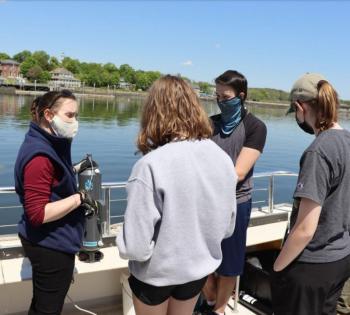 Water collection with Dr. Poulton, holding a YSI. Courtesy of Bruce Wood
Water collection with Dr. Poulton, holding a YSI. Courtesy of Bruce Wood
 Collecting zooplankton and phytoplankton with Dr. Fields. Courtesy of Bruce Wood
Collecting zooplankton and phytoplankton with Dr. Fields. Courtesy of Bruce Wood
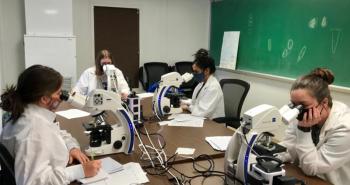 Eye-counting and identifying the various phytoplankton with Laura Lubelczyk, a research assistant in phytoplankton. Courtesy of Laura Lubelczyk
Eye-counting and identifying the various phytoplankton with Laura Lubelczyk, a research assistant in phytoplankton. Courtesy of Laura Lubelczyk
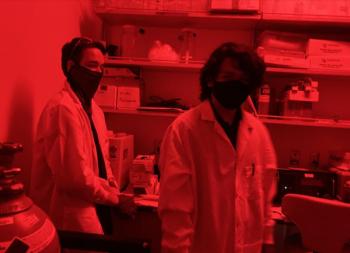 Physical and chemical testing with Sydney Greenlee using the Seal AA3 Auto Analyzer. Courtesy of Sydney Greenlee
Physical and chemical testing with Sydney Greenlee using the Seal AA3 Auto Analyzer. Courtesy of Sydney Greenlee
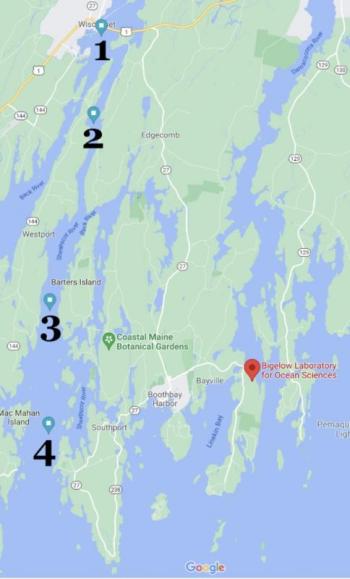 The locations of the four stations are shown in bold black numbers. Station 1 is upriver in Wiscasset, heading down river is Station 2 in the Narrows, Station 3 in the Gut, and Station 4 is off Southport island. Google Maps
The locations of the four stations are shown in bold black numbers. Station 1 is upriver in Wiscasset, heading down river is Station 2 in the Narrows, Station 3 in the Gut, and Station 4 is off Southport island. Google Maps
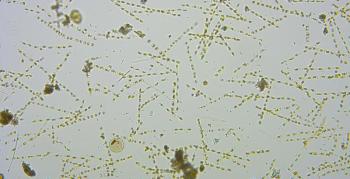 This photo, taken by a telescope, shows a low biodiversity due to the dominant amount of skeletonema, who look like thin lines made up of rectangles. Courtesy of Laura Lubelczyk
This photo, taken by a telescope, shows a low biodiversity due to the dominant amount of skeletonema, who look like thin lines made up of rectangles. Courtesy of Laura Lubelczyk
The 32nd annual Keller BLOOM Program at Bigelow Laboratory of Ocean Sciences took place last month, from Sunday, May 16 to Friday, May 21. A free and application-based program, BLOOM selects 16 high school juniors from across Maine to participate in six days of hands-on research in the exciting field of marine science. As one of the students to live and work at the lab during this period, it has been an extremely insightful, motivating experience that has undoubtedly reshaped my plans for the future.
Undeterred by COVID-19 and successfully abiding health regulations, Bigelow reached its 500-student mark this year. So far, all BLOOM graduates have completed high school and gone to college. Around 60% live in Maine and are involved in the fields of science or math. I can personally vouch for how influential this program is in encouraging students to seriously think about going into a science career, as it provides an immersive experience in a natural laboratory setting, and fosters collaboration with scientists who are truly passionate about their research.
The theme of the BLOOM program is designed around its acronym: Bigelow Laboratory Orders of Magnitude. Oceanographic research is a multidisciplinary field that can be performed at levels as small as the microliter sphere, and then be applied to entire global ecosystems. At BLOOM, we sought to learn more about the ocean’s order of magnitude, specifically discovering the correlation between the size of plankton and its quantity within the ocean. We confirmed that the smaller an organism is, the greater its population. For example, in 1 milliliter, or 1/5th of a teaspoon of water, 10-100 mesoplankton can be found, compared to the 1-10 million femtoplankton present. Mesoplankton, such as copepods, can range from 1cm to 10 micrometers in length, whereas femtoplankton, which are bacteria and viruses, are only 1 to 0.1 micrometers long.
To test how these varying populations are affected by the physical properties of Maine’s natural aquatic environment, we spent our first full day on a cruise down the Sheepscot River. Stopping at four locations to collect four different samples proved a fast paced, exhilarating fight against both time and weather.
The 16 students were split into four groups and rotated stations at each stop. I began with the collection of zooplankton and phytoplankton with David Fields, Ph.D., a senior research scientist and zooplankton ecologist. Using a net tow with a 20 micron net, I had the pleasure of getting my hands dirty to sample out plankton which would then be preserved in lugol’s, an iodine solution used for Gram staining.
These samples were brought back to the lab the next day, where the phytoplankton and zooplankton in 1 milliliter of water were eye-counted through telescopes. The zooplankton samples revealed a large population of copepods, while the phytoplankton group discovered a shocking abundance of skeletonema, a diatom that made up 98% of the entire sampled plankton population.
We also looked into the chemical and physical properties of the water during the cruise. With Ben Twining, a senior research scientist and also vice president of education at Bigelow Lab, we were able to collect chlorophyll and chemical nutrient samples through a 60 milliliter syringe. We then collected physical data with Maura Niemisto, a research associate, and Sydney Greenlee, a Ph.D. student, who were also our chaperones at the dorm. Using a YSI, a sensing instrument that can be used to measure different properties of water, we recorded the salinity, temperature, levels of nutrients, oxygen levels, and chlorophyll fluorescence at the different stations.
When taken to the lab, these statistics helped determine the types of organisms that lived in the water and why those populations vary. For example, a higher chlorophyll fluorescence would be an indicator of a higher population of plankton. Murkier water with low turbidity meant a higher chance of polychaetes, an annelid worm that prefers staying closer to land.
After a peaceful lunch and hiking excursion, we embarked on a final station with Nicole Poulton, Ph.D., a senior research scientist in phytoplankton ecology, and FAC director at Bigelow Lab. After throwing a 5 liter Niskin bottle into the river to collect a sample of surface water, back at the lab it was revealed that in one milliliter of the sample, millions of viruses and bacteria were present.
The rest of the week was spent compiling data in preparation for a presentation to the public. Each day, I reflected on how my love for the field of biology was growing, and pictured myself being just like Dr. Poulton or Dr. Fields, conducting research in a lab. My admiration for these scientists is driven by their vast knowledge and capabilities and the passion they excitedly exhibit when asked about their work. Despite the mask, I could tell Dr. Fields was beaming a wide smile while discussing his research on why copepods mate, and how this study can be applied to the understanding of hearing in the ear. The scientific community is always reaching towards something greater in their research, and as I look towards my future, I’m inspired to be a part of it. I hope to return to the Bigelow Lab this summer and assist the scientists in their studies, all the while nurturing my ever growing avidity for biology.
The full list of students in Bigelow Laboratory’s 2021 Keller BLOOM program is: Blake Austin - Brunswick High School; Alice Bonnevie Rothrock - South Portland High School; Riley Bradway - Marshwood High School; Grace Campbell - Boothbay Region High School; Lilly Curtis - Camden Hills Regional High School; Della Hahn - BRHS; Claire Holman - Maranacook High School; Ashley Mason - Skowhegan High School; Delaney Pascuzzo - Morse High School; Wyatt Rhodes - Medomak Valley High School; Phoebe Richards - Gorham High School; Marcus Russano - Lincoln Academy; Amber Stokes - John Bapst Memorial High School; Claire Walker - Scarborough High School; Sadie Woodruff - CHRHS; and Sadie Yentsch - Kennebunk High School.
Lilly Curtis will be attending Boothbay Region High School this coming fall. Since her freshman year at Camden Hills Regional High School, she has written for the school’s newspaper, the Camden Hills Gazette.
Event Date
Address
United States

